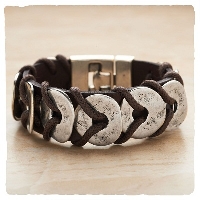
Artisan jewelry is often a one of a kind creation designed or crafted by artists
In order for jewelry to be considered “artisan,” it must be handmade by a skilled craftsman and typically involves a variety of materials one does not normally associate with traditional jewelry. Whereas classic ?fine? jewelry consists primarily of precious metals and jewels, an artisan is free to experiment.
This leads to gorgeous, often one-of-a-kind jewelry creations that can be fun and casual or beautifully formal.
Metalsmithing
Many artists work with various metals to create unique pendants, bracelets, and other pieces. Using the tools of their trade, metalsmiths can mold, cast, engrave, and pound the metal into various shapes and to give the piece certain textures. They also learn the art of patina, a process by which they can ?age? the metal to give it an antiqued or darkened appearance.
Beading
One of the most recognizable forms of making jewelry by hand is the art of beading. Beads can be made of almost any material?from glass to wood to animal bone?and in almost any shape.
Jewelry makers are able to create amazing displays of color and shape through the seemingly simple task of stringing beads in different patterns and tying knots. Don’t let the description fool you, however. Working with these sometimes miniscule bits of colored material is harder than it looks.
~
Leatherworking
Leather jewelry is not a new thing, but its popularity is rising. Craftworkers learn to burn, stamp, dye and cut leather into wearable adornments, like earrings or bracelets. Sometimes this is as simple as several different colored leather chords braided together, but it can also be as complex as detailed pictures or symbols burned or stamped into a single piece.
Leather is often used in conjunction with other materials to soften or brighten its look.
Wire Working
Jewelry wire, made of various metals and of different thicknesses, is often worked into artisan jewelry.
A skilled wire worker can, however, design an entire piece made exclusively of wire. The material is bent and manipulated into various shapes, sometimes functional, such as creating a ?cage? to hold a semi-precious stone or pendant, and sometimes simply decorative. It can be coiled tightly to create strong bracelets or ear cuffs. The wire can also become a decorative pendant in its own right, as the artist bends, coils, and shapes it into various shapes.
Upcycled Jewelry
An interest in upcycling–the practice of giving useable trash new life—has led to a literal explosion of crafters and artists making wearable art from things which would normally end up in a landfill.
Anything from discarded beverage bottles to old computer parts are fair game as people think up the most creative ways to reuse our trash. In order to make a statement, this jewelry is sometimes obvious in its upcycled nature, showing off the product labels of soft drink cans or the script in a castoff book, for example.
In other works, however, the materials are so masterfully manipulated that you wouldn’t know these adornments had a former life as, say, the spoke of a ten-speed bicycle.
Oftentimes, jewelry makers will use a combination of any or all of these techniques. They can include natural elements, such as feathers or seashells, for a rustic look. Some artists specialize in ?industrial? jewelry, using such materials as nails, metal grommets, and pieces of clockwork to create an urban feel. Others are more into the fine art of the work, creating artful, elaborate pieces that fetch premium prices the world over.
